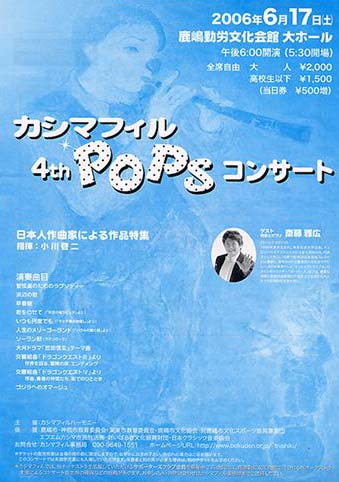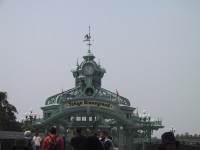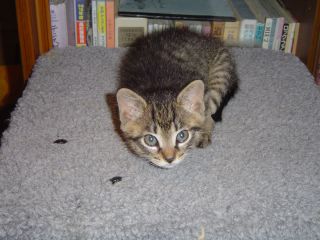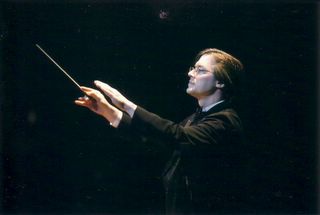
Holy pizzicato, Batman! Are we really up to our fourth annual POPS concert? It's unbelievable the way time flies! It seems like only yesterday that Mr. Ogawa decided to come out of his office and take temporary control of the sadly foundering Kashima Philharmonic (off-key fanfare) and show Mr. Sato, the director at the time, how the job was done. He wasn't very kind, and there were some hard feelings, but he managed to whip that poor excuse of a community orchestra into shape and prove to them that they didn't have to suck. He also showed that, with a good program, a good performance, a few perks, and a few risks here and there, we could not only attract an audience (something sadly lacking in our previous concerts) but could pack the house and keep them coming back. That was the first POPS concert. Mr. Sato took the baton again for a classics concert the following December, but he went right back to his old pattern, and the results were rather dismal. That led Mr. Ogawa to direct a second POPS concert the following June, and it was an even bigger success than the first. Perhaps not surprisingly, Mr. Sato quit soon afterward, and Mr. Ogawa's role as "temporary" conductor wound up lasting a bit longer than intended (not that we complained much). The Kashima Philharmonic has followed a pattern of a June POPS concert and December classics concert ever since.
Well, this time it was POPS number four. We were coming off of the surprising successes of our last two classics concerts and POPS number three, all of which turned out rather well and made a huge impact on our audience. Just a few years ago we never would have thought ourselves capable of playing at this level, so we were feeling pretty high on ourselves. I think we were also a bit intimidated at the increased demands being placed on us.
POPS number three had a movie music theme, and it worked really well. Because of that, it was decided that we should have a theme again this time around. Several were suggested, but none of them seemed good for one reason or another. Then I offered a suggestion of my own...one that seemed strange and even controversial but also seemed like it might just work. Without much discussion, Mr. Ogawa decided to go with it, and the program was put together.
The theme for POPS number four?
Japanese music.Actually, it wasn't as easy to put together as it would seem. The first choice was obvious: Toyama's
Rhapsody for Orchestra, a dynamic piece based on traditional Japanese festival music. After that we started drawing blanks. Eventually, we decided on adding a few well-known Japanese folk songs (sung by a guest vocalist), a collection of tunes from famous Studio Ghibli animated movies (
Spirited Away,
Haul's Moving Castle,
Laputa), and a number of movements plucked from the musical suites of the background music for the video games DragonQuest III and IV.
It was an interesting program, and it was plenty challenging as it was. The folk songs and Studio Ghibli pieces were easy enough, but
Rhapsody wasn't. The DragonQuest tunes, which had originally been written for MIDI (i.e. no worries about the limitations of the instruments), were far worse. It would've been a handful even if they'd left it at that...and there wasn't much chance of that.
About two months before the concert Mr. Ogawa added
Takeda Shingen, the rousing theme to a popular TV samurai drama from the 1980s. That turned out to be nothing at all compared with what showed up only a month before the performance.
You see, as with our previous POPS concerts, we'd brought in a celebrity guest emcee. This time it was
Masahiro Saito, a famous pianist perhaps best known for his musical clown character "Key-bozu" (a play on "keyboard" and "Bozo") on a popular educational TV program centering on music (which I used to enjoy watching with my daughter when she was really little). Naturally, he didn't just want to emcee; he also wanted to play. Naturally, he wanted to perform a barn burner. He sent us the music just a month before the concert, and when Mr. Ogawa and I first opened the package and looked at it we just about had a heart attack. The piece was
Ritmica Ostinata for Piano and Orchestra by
Akira Ibukube, the same guy who wrote the famous theme to the original Godzilla movies.
Ritmica is positively
INSANE. Almost every measure is in a different time signature, and the meter is constantly flipping around. It is based on a regular theme, so there is a sort of method to the madness, but you have to stay on your toes constantly or wind up getting tangled up in the vines of beat and rhythm. We didn't think the Kashima Philharmonic stood any chance of playing it, but there was no turning back. It was do or die.
Actually, our first attempt at
Ritmica went surprisingly well, and Mr. Ogawa's spirits lifted again. We somehow managed to get through it more or less together. Still, it was a horribly demanding piece, and trying to get it ready within a month wound up eating up an awful lot of rehearsal time that probably should have been used for the other tunes, some of which were also challenging enough. That wound up costing us. The first full-member rehearsal including all guests and extras was the day before the concert, and it was a bit rough to say the least. (Still, I should be fair. Four years ago we weren't playing even half that well.)
Ritmica was especially disastrous in rehearsal, and the reason was surprising. We had it down, but Mr. Saito apparently didn't. We'd all feared he'd launch into it at an insanely fast, "Hey, look at THIS" tempo, and that was exactly what he did. However, as it turned out, he wasn't able to play it at his own tempo. He was all over the place, flopping and banging around, suddenly slowing down and then speeding up again. After it was done, he stood up, looked at us, and said, "Don't panic, and don't run from it. Just stay with it, and you'll do fine." (After he left, Mr. Ogawa said, "As soon as we start, I'll force him back into a slower tempo." That got some laughs and some sighs of relief.)
(Perhaps I should also point out that, in earlier rehearsals, Seishin student and Flying Egghead pianist Chiaki Oshima [yes, that's her in the picture] learned and played that barbaric piano part herself...and in many ways did a better job!)
Cut to the performance. Because of the Japanese theme, I'd wanted us all to dress up in
yukata (summer kimonos), but the non-foreign members of the orchestra opted for Western dress shirts and ties. (sigh...) However, the percussion section did put on
haori (festival costume) for the opening number, which was only appropriate as it was
Rhapsody...featuring all manner of traditional Japanese percussion including a solo on a big, old
taiko drum by Mr. Fujiki, our visiting percussion clinician!
Rhapsody is a very passionate number, and it went very well...definitely an excellent start.
Next was the song segment. Ms. Kuroda, currently teaching vocal music here at ye olde academy, was our guest vocalist. She's a very talented and competent singer, but she's of a more operatic bent. I thought she sounded fine on the Japanese folk songs, but when we did the famous numbers from
Spirited Away and
Laputa I thought her singing was a bit heavy...not quite as enjoyable as the light, airy vocalizations of the guest singer who'd sung the same tunes with us in POPS concert number two. Still, that's just my impression, and I'm sure many wouldn't agree.
Next up was
Takeda Shingen, which is a very bold, brassy number. Unfortunately, our brass was starting to fall apart. To be fair (and respectful), our horn section...long our Achilles' heel...did a fantastic job with some particularly brutal, high, roaring passages. The trombone section, on the other hand, did not. Bass trombonist Uchida was solidly on the mark, but the other two players in his section were clearly blown out from overrehearsing (or maybe underrehearsing over the past couple of months?). They splattered every other entrance and fought to stay on pitch throughout the tune. It was upsetting considering the fine performances being delivered by the rest of the orchestra. The fact that it was followed by
Ritmica was very worrying, but the tune actually went rather well (because Mr. Ogawa forced it to stay at the prescribed tempo).
POPS concerts two and three both featured interludes of big band jazz featuring me on solo clarinet. We also had a jazz break this time, but I played tenor sax (with no solo), and we performed a Latin jazz/rock version of the Hokkaido folk song "Soran Bushi". The tune went brilliantly during rehearsal. The performance itself was a near-total disaster. Guest drummer Hasegawa started out, as always, with an excellent drum solo. However, he started the tune too slow. The bassist stumbled over the opening riff. After my countoff, the band came in (sloppily), and the audience immediately started clapping along. Unfortunately, the audience tempo didn't match our tempo. That threw off the trumpet section, who wound up playing a full measure ahead before realizing their error (by blowing a critical entrance). To top it all off, two of the kids playing in the sax section (both Eggheads) couldn't figure out a simple dance step we'd worked up for a certain riff, and they more or less jerked around at random. It was a comedy of errors, but the audience still seemed happy.
The second half was mainly taken up by the DragonQuest tunes. Those went quite well for the most part (except for the agonizing splats that kept coming from the trombones and sometimes the trumpets). I had two difficult solos, and I nailed both of them even though (or maybe even because) I was feeling dizzy and nauseous (and desperately trying to keep my lunch from exploding from my bowels). There was also one tune, the "Ending" from DragonQuest III, that had a really fast, complicated run I didn't think any of the woodwinds would ever be able to play, least of all myself. Well, we nailed it solidly. (And then after that there were some pretty out-of-tune power chords from the brass...%$#@*!!!)
The encores included one song/piano performance involving Ms. Kuroda and Mr. Saito, another piece from DragonQuest III, and....once again....Elgar's
Pomp and Circumstance. It all ended with balloons flying and a standing ovation.
When we got the audience questionairres back most of them were very favorable, but we did get some scathing attacks. Most of those were directed at the trombone section if not the brass as a whole (or even
all the wind instruments for some reason). There was also a surprisingly large number of complaints about the repertoire. Apparently the idea of us playing an all-Japanese concert didn't go over well with some people. They want their European classics and American Broadway/Hollywood numbers. No native fare, please.
I guess it'll always be up to us
gaijin to preserve and defend the native culture from rampant Westernization.
Definitely not one of our better performances, but it did have its moments. Besides, it was still a lot of fun, and most of the audience went away happy. In any case, tackling
Rhapsody,
Ritmica, and DragonQuest definitely gives me some more notches to put on my belt.
Now...what are we gonna play next December? Beethoven? Shostakovich? Salieri? (Salieri? Now
that is a challenge!)








